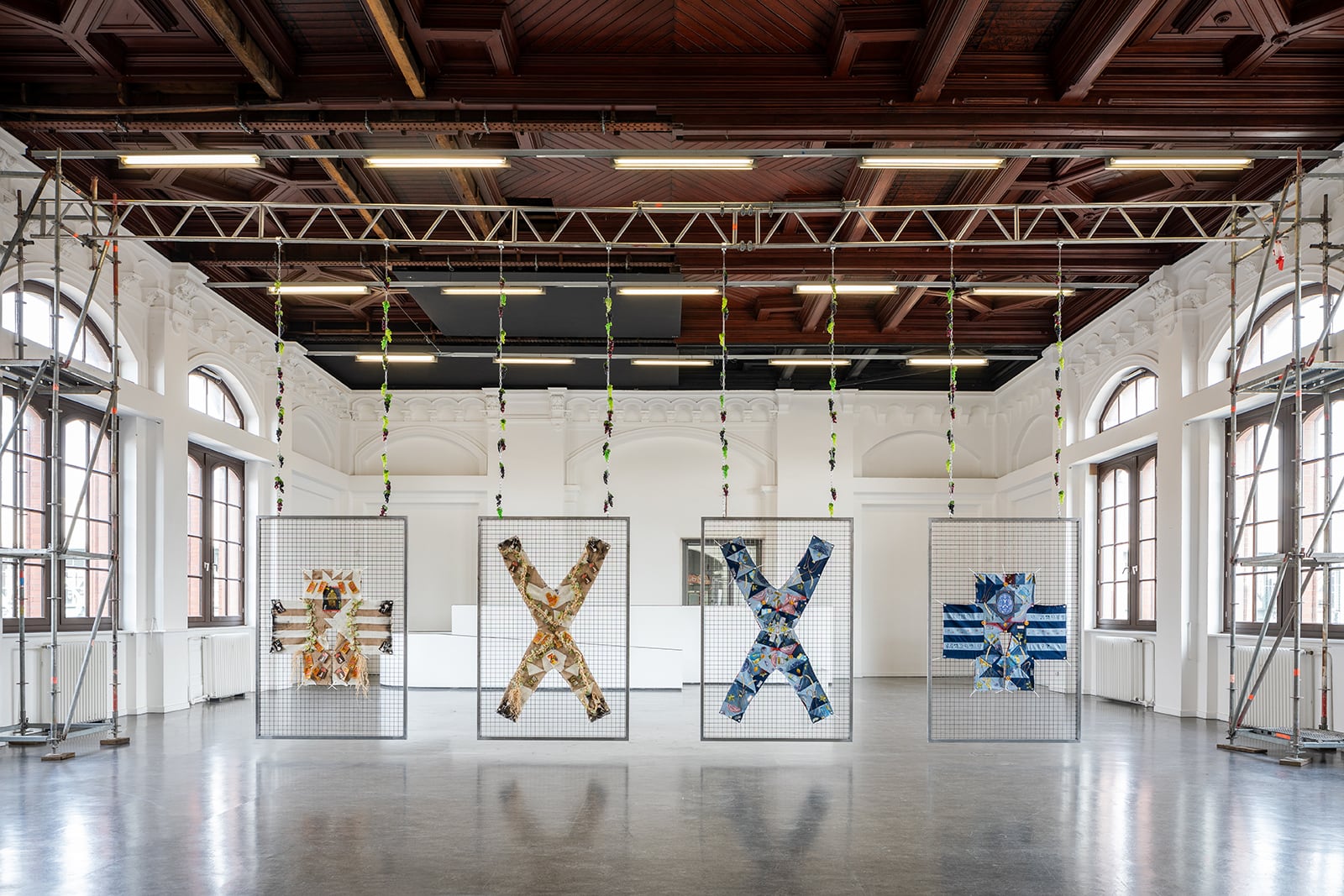 Installation view
Installation view
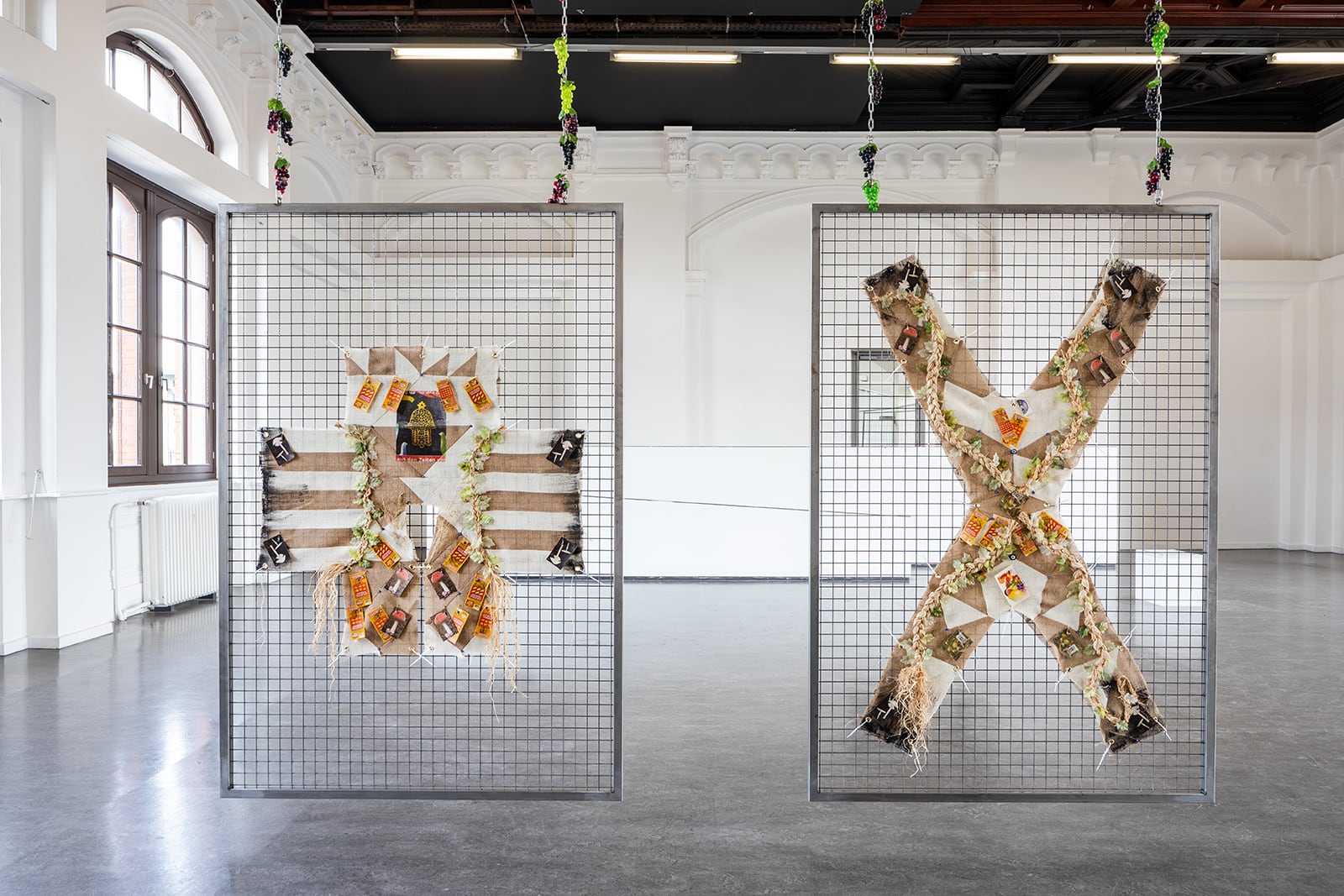 Elif Saydam, The Drone I, Nazar charms, wild oats, raffia, silk, eyelets, inkjet transfers and squid ink on jute; steel frames 250 x 170 cm, 2021 / The Drone II, Nazar charms, raffia, silk, eyelets, inkjet transfers and squid ink on jute; steel frames 250 x 170 cm, 2021
Elif Saydam, The Drone I, Nazar charms, wild oats, raffia, silk, eyelets, inkjet transfers and squid ink on jute; steel frames 250 x 170 cm, 2021 / The Drone II, Nazar charms, raffia, silk, eyelets, inkjet transfers and squid ink on jute; steel frames 250 x 170 cm, 2021
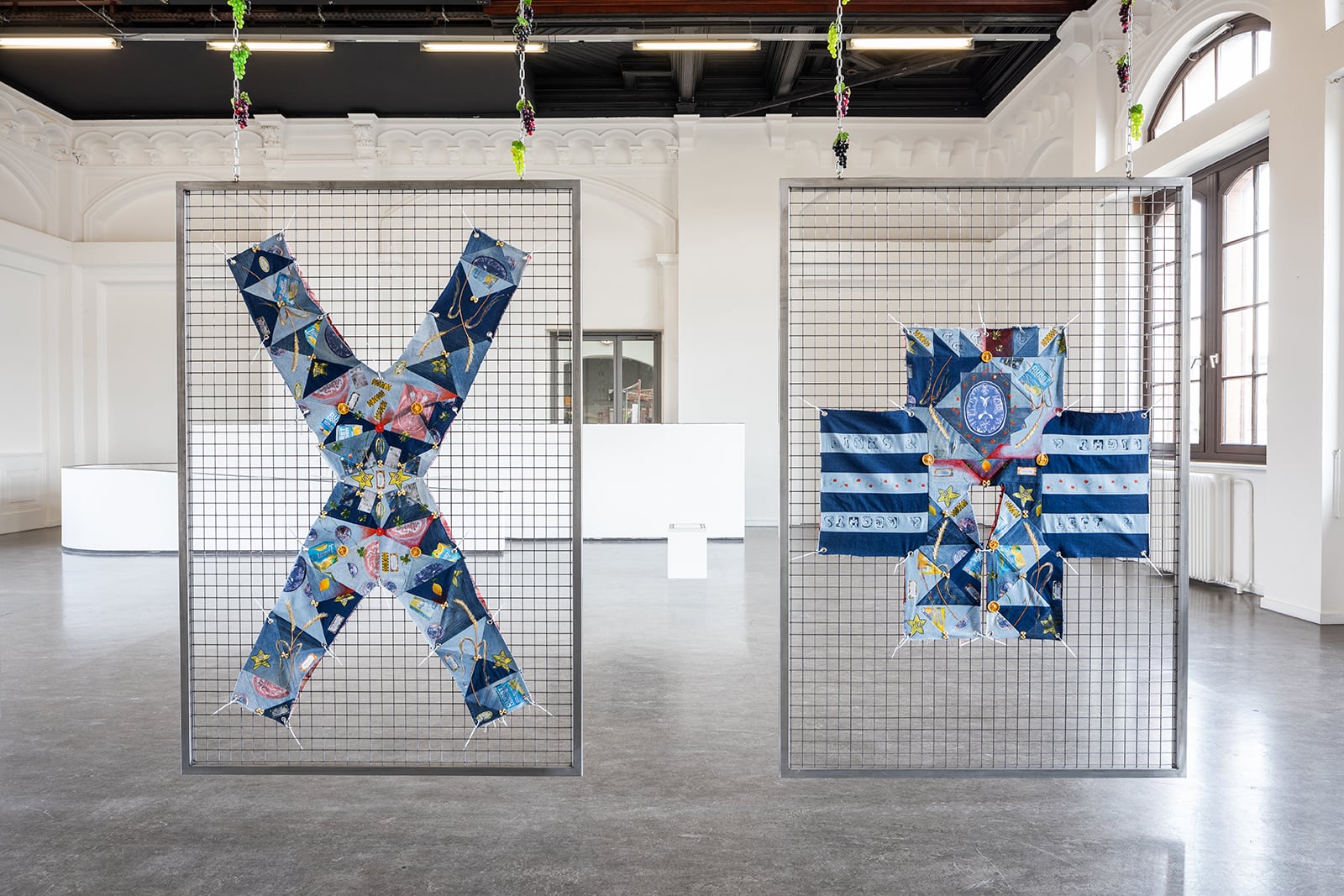 Elif Saydam, The Producer I, Farfalle pasta, 24 k gold, copper, orange slices, beads, sequins, embroidery, eyelets, inkjet transfers and oil on denim; steel frames 250 x 170 cm, 2021 / The Producer II, Farfalle pasta, 24 k gold, copper, orange slices, beads, sequins, embroidery, eyelets, inkjet transfers and oil on denim; steel frames 250 x 170 cm, 2021
Elif Saydam, The Producer I, Farfalle pasta, 24 k gold, copper, orange slices, beads, sequins, embroidery, eyelets, inkjet transfers and oil on denim; steel frames 250 x 170 cm, 2021 / The Producer II, Farfalle pasta, 24 k gold, copper, orange slices, beads, sequins, embroidery, eyelets, inkjet transfers and oil on denim; steel frames 250 x 170 cm, 2021
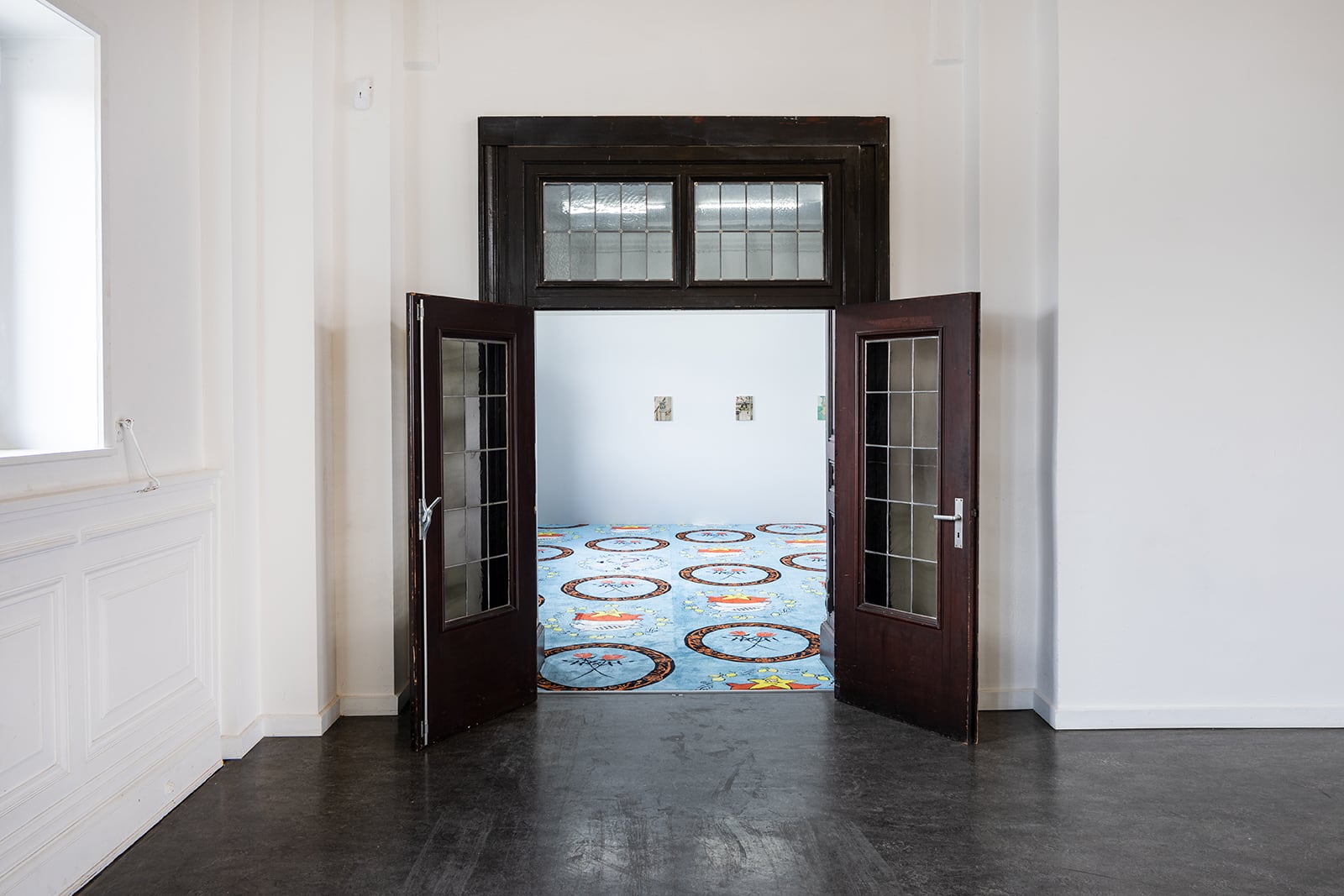 Elif Saydam, Blue Saloon, Custom carpet, 2021
Elif Saydam, Blue Saloon, Custom carpet, 2021
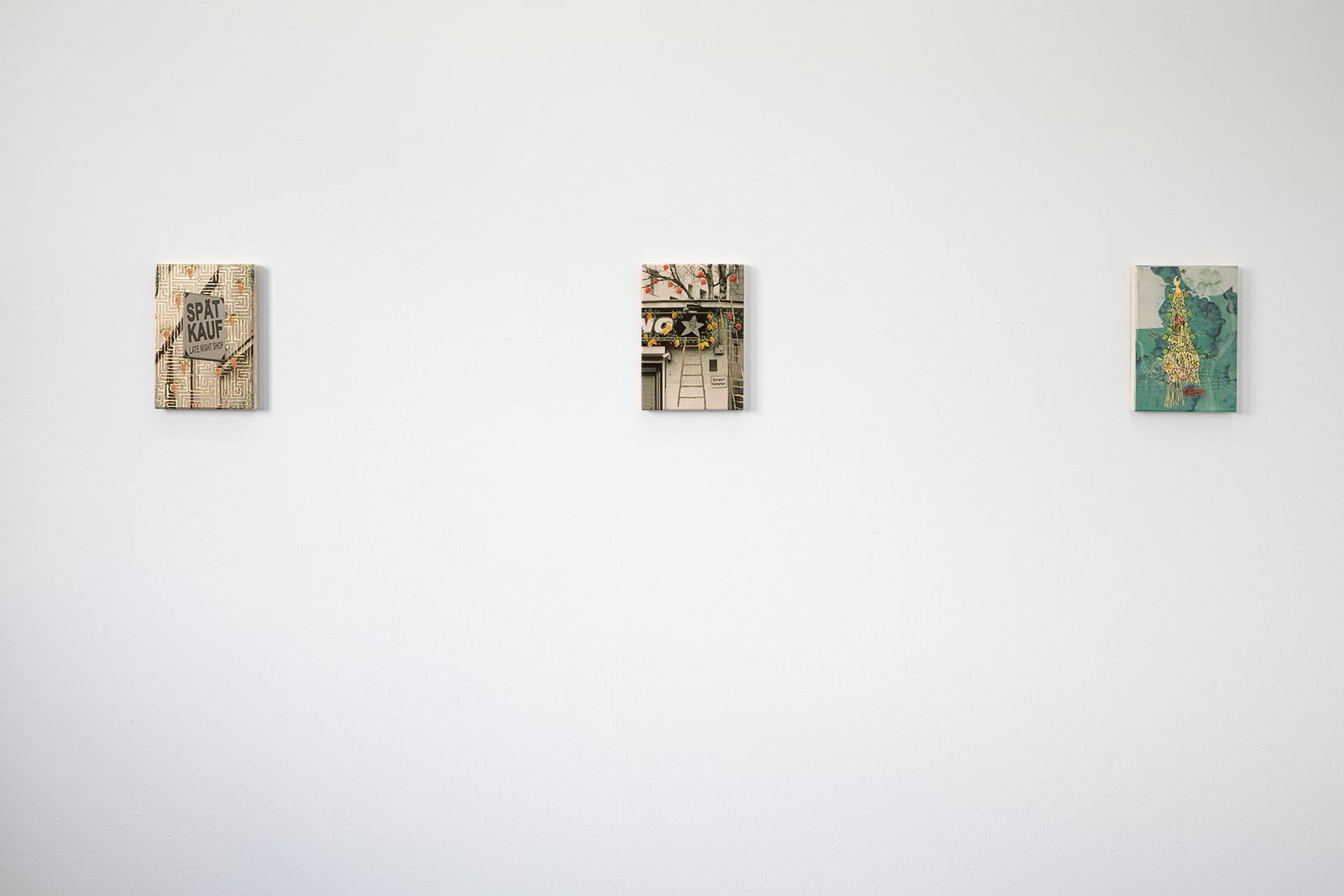 Installation view
Installation view
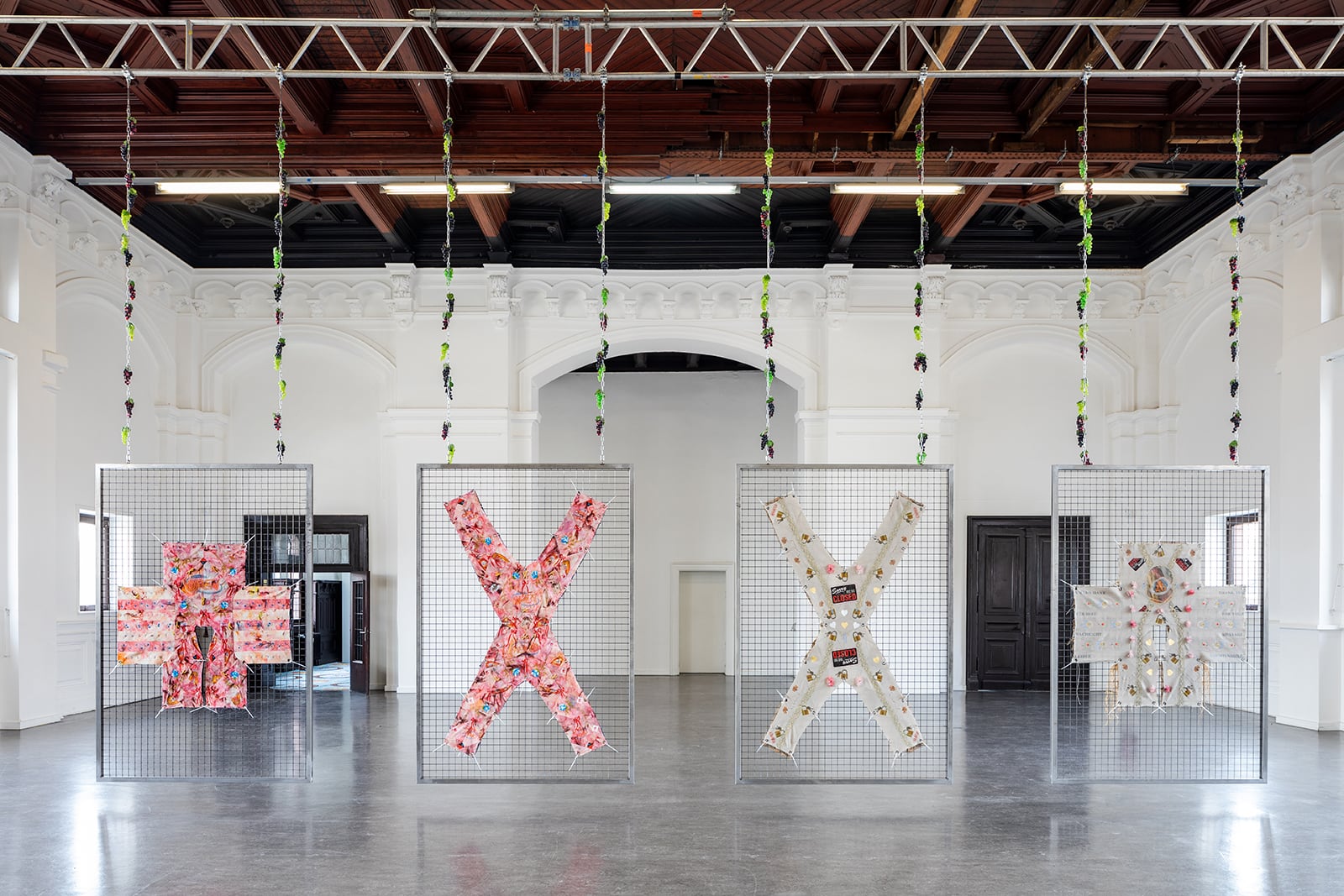 Installation view
Installation view
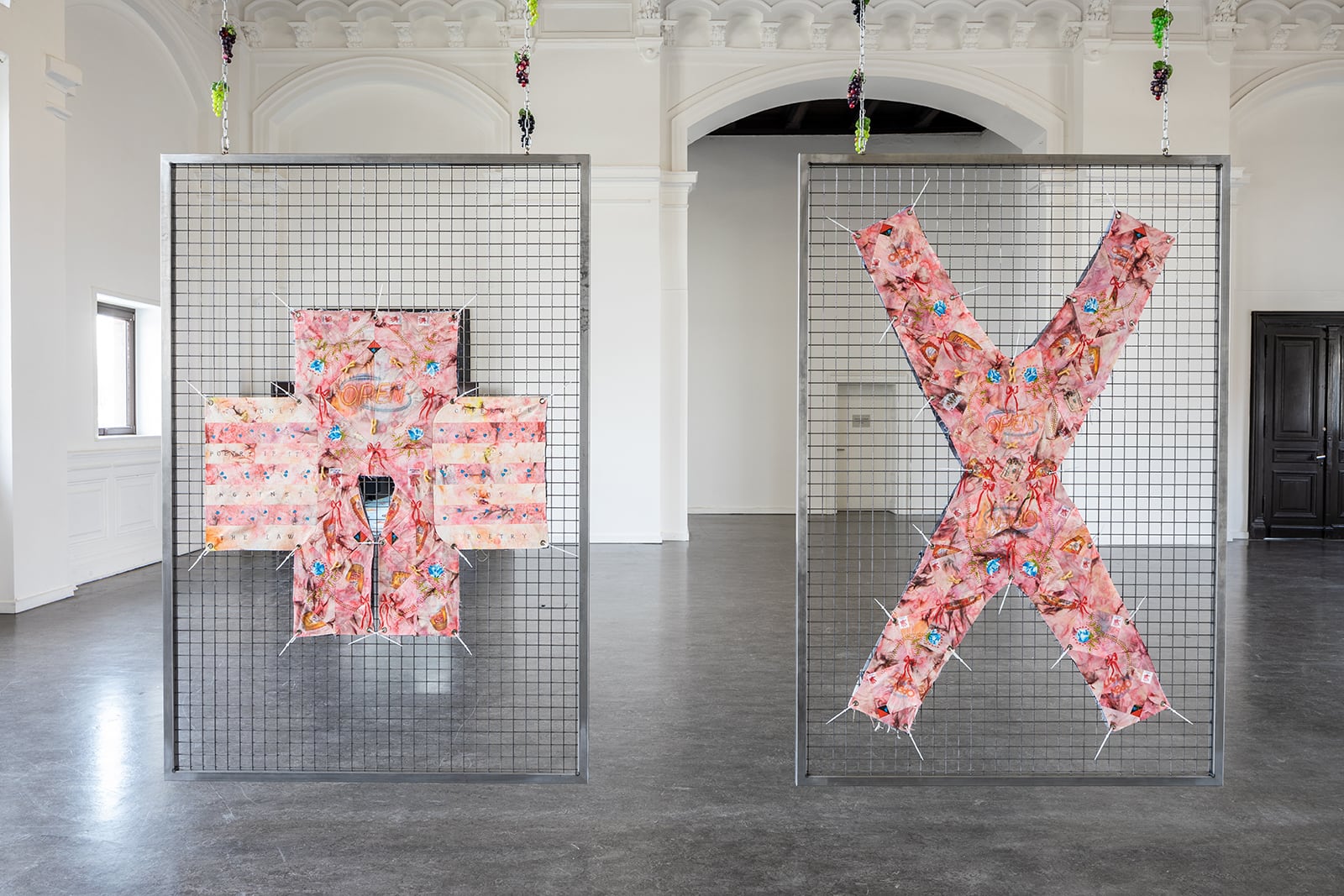 Elif Saydam, The Outlier I ,Beeswax, beads, sequins, embroidery, eyelets, inkjet transfers and oil on dyed canvas; steel frames 250 x 170 cm, 2021 / The Outlier II, Beeswax, beads, sequins, embroidery, eyelets, inkjet transfers and oil on dyed canvas; steel frames 250 x 170 cm, 2021
Elif Saydam, The Outlier I ,Beeswax, beads, sequins, embroidery, eyelets, inkjet transfers and oil on dyed canvas; steel frames 250 x 170 cm, 2021 / The Outlier II, Beeswax, beads, sequins, embroidery, eyelets, inkjet transfers and oil on dyed canvas; steel frames 250 x 170 cm, 2021
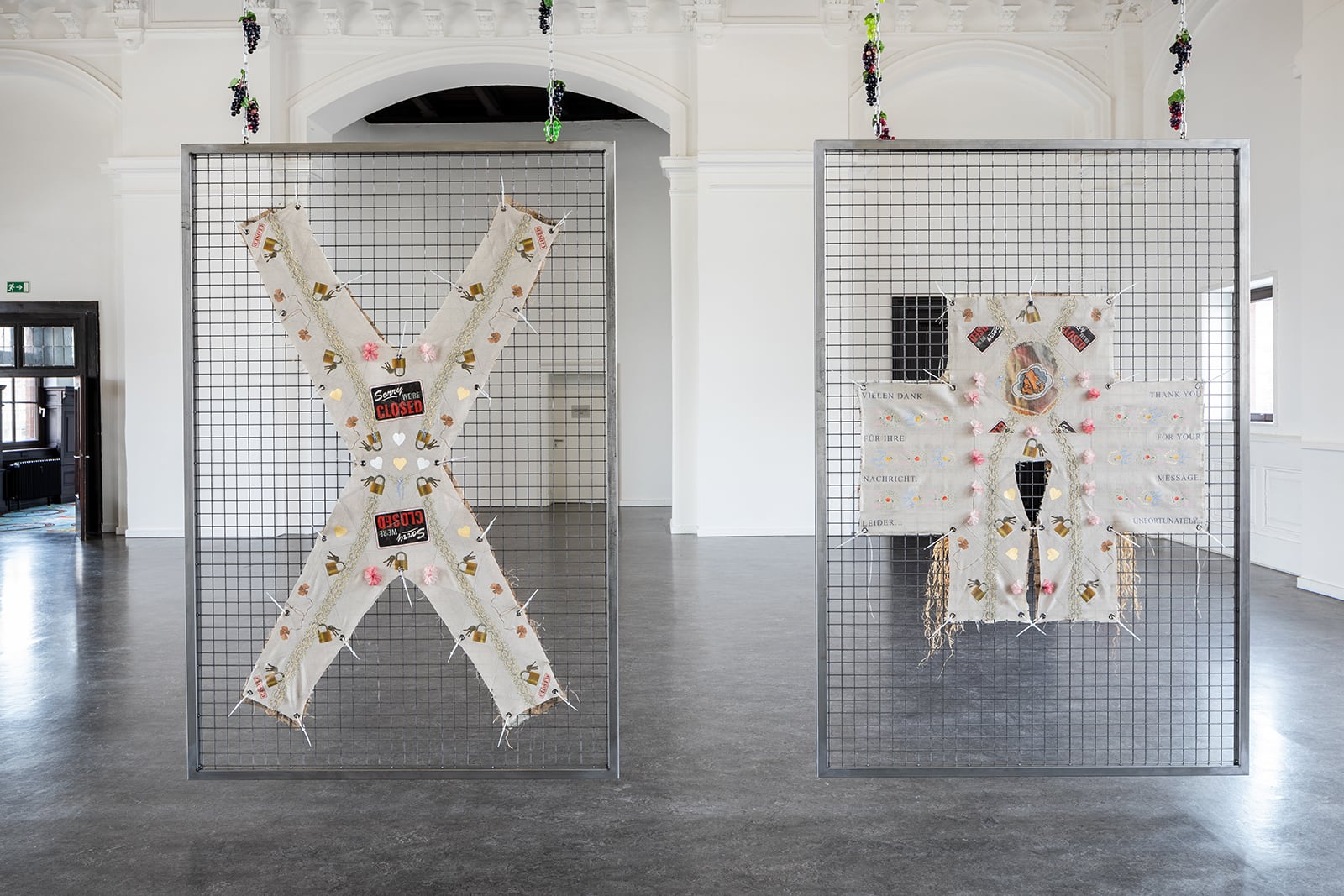 Elif Saydam, The Landlord I, Silk, beads, 23 k gold, 24 k gold, pure silver, eyelets, inkjet transfers and oil on linen; steel frames 250 x 170 cm, 2021 / The Landlord II, Silk, beads, 23 k gold, 24 k gold, pure silver, eyelets, inkjet transfers and oil on linen; steel frames 250 x 170 cm, 2021
Elif Saydam, The Landlord I, Silk, beads, 23 k gold, 24 k gold, pure silver, eyelets, inkjet transfers and oil on linen; steel frames 250 x 170 cm, 2021 / The Landlord II, Silk, beads, 23 k gold, 24 k gold, pure silver, eyelets, inkjet transfers and oil on linen; steel frames 250 x 170 cm, 2021
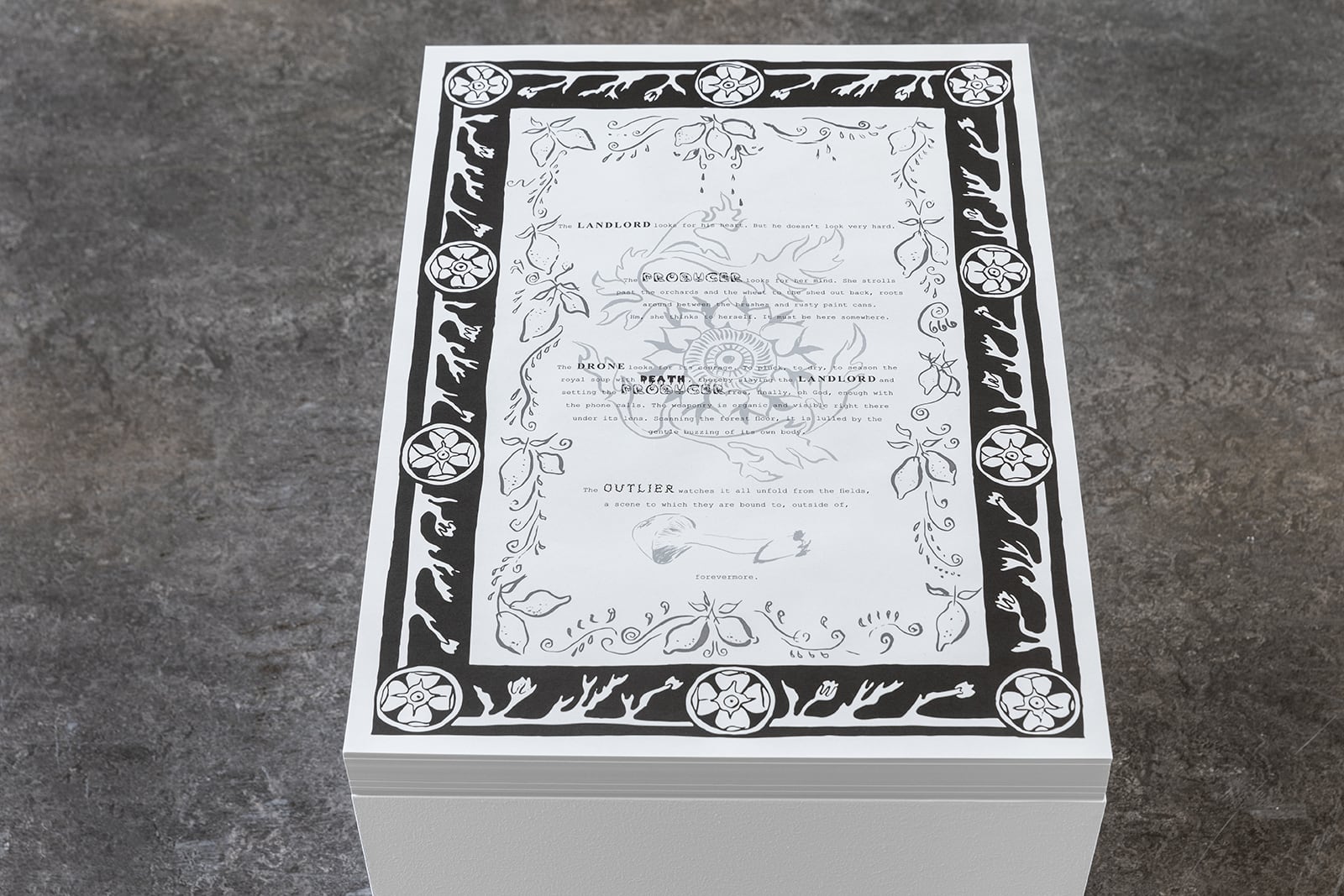 Elif Saydam, Legend, Offset print, A2 (42.0 x 59,4 cm), 2021
Elif Saydam, Legend, Offset print, A2 (42.0 x 59,4 cm), 2021
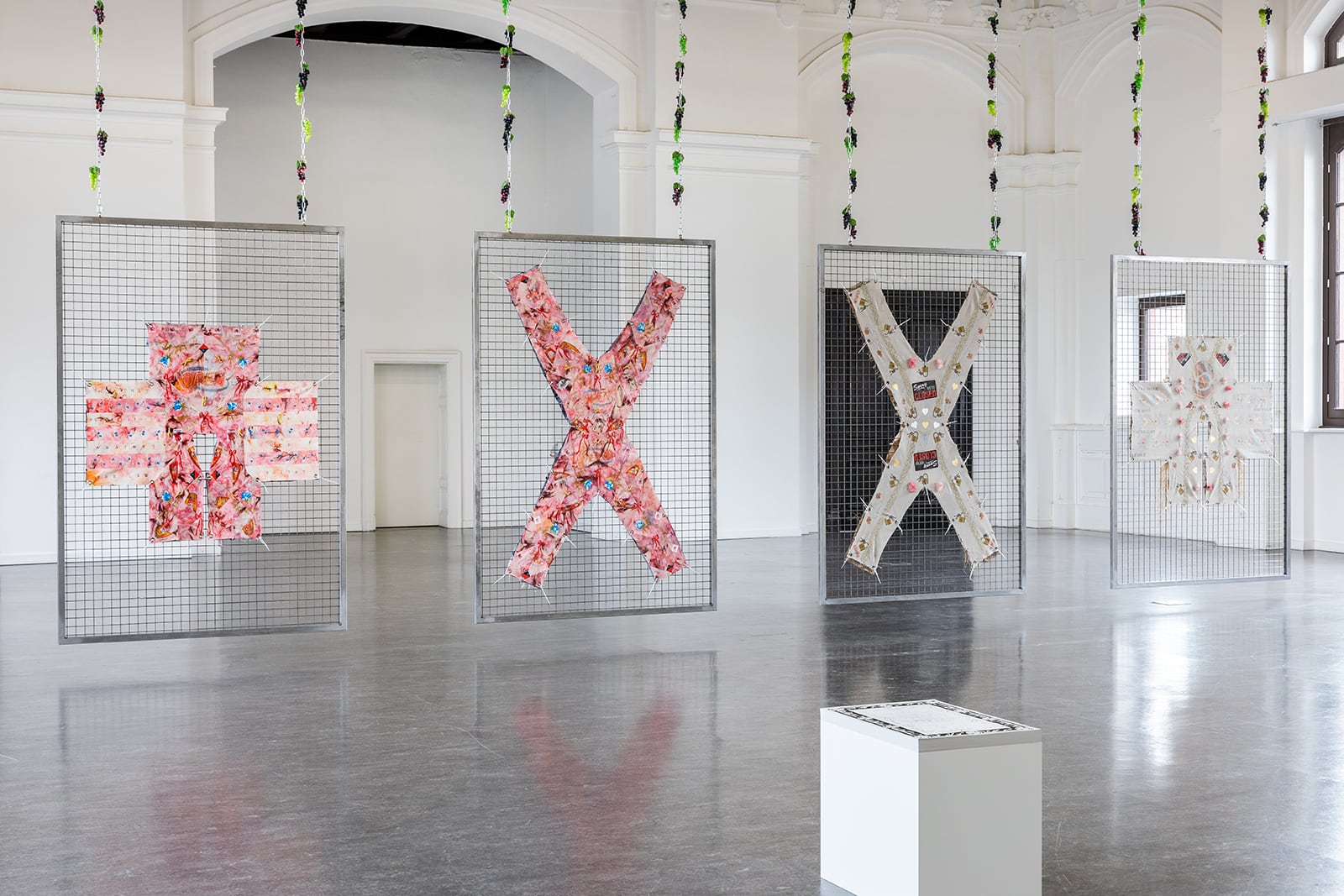 Installation view
Installation view
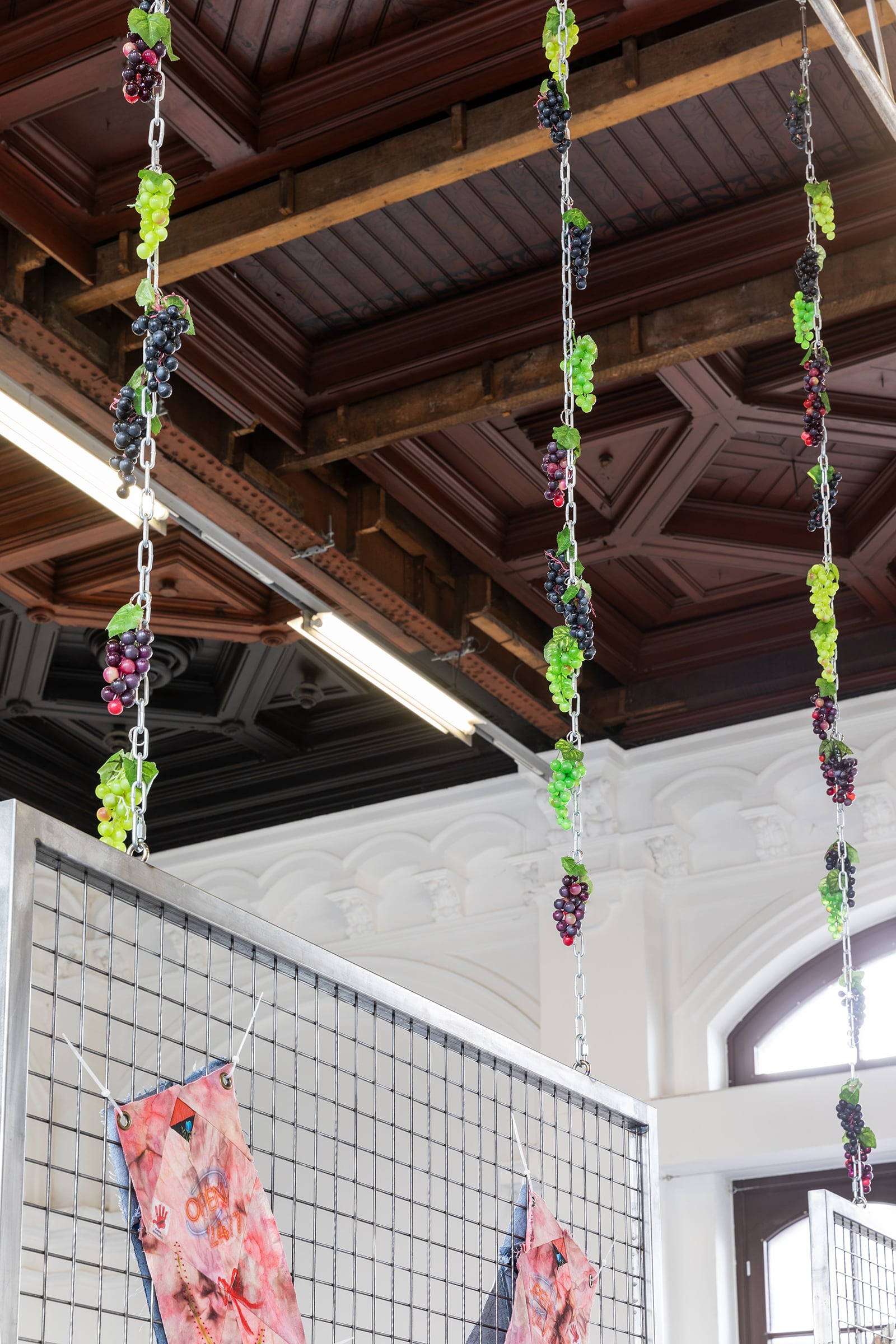 Installation view
Installation view
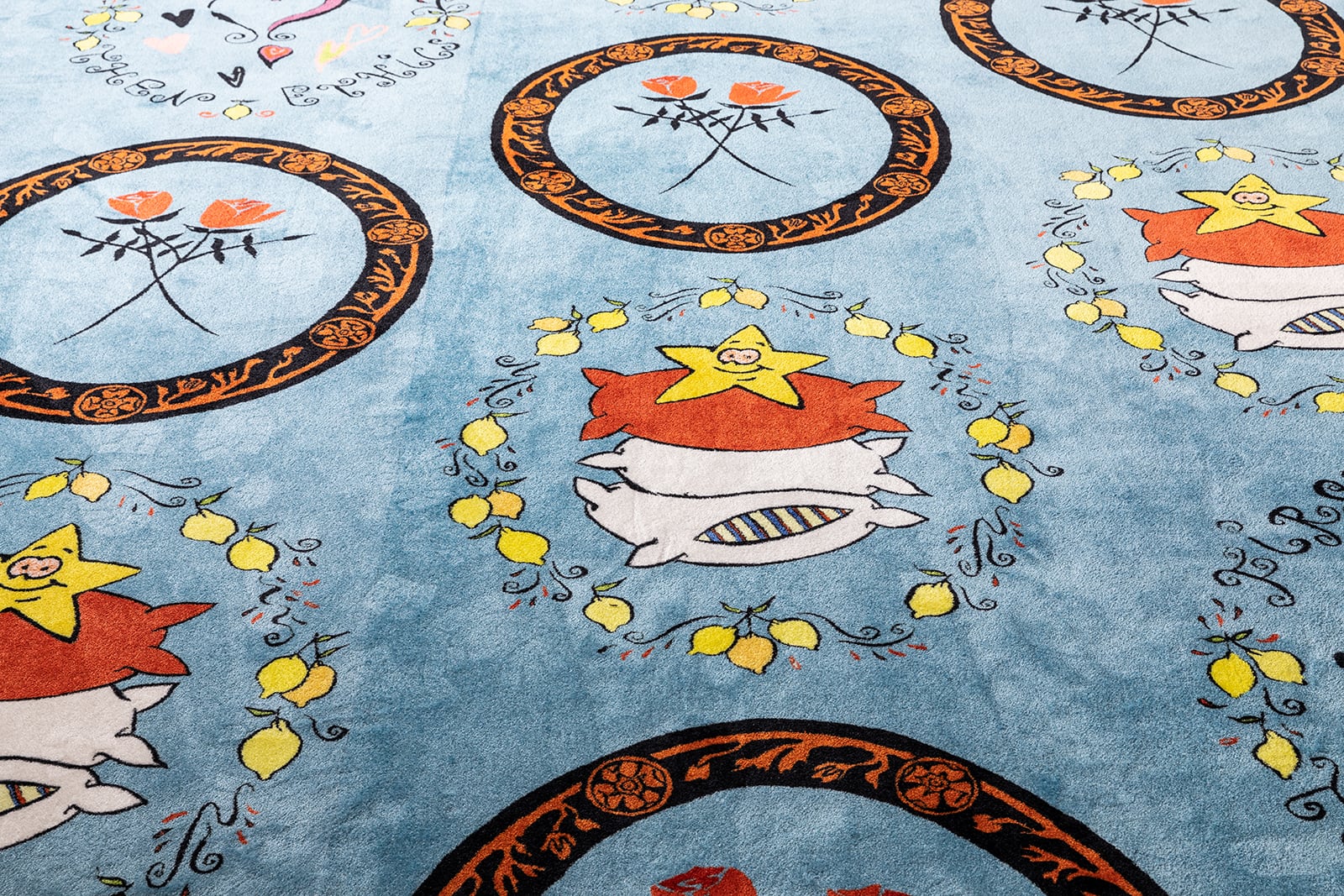 Elif Saydam, Blue Saloon, Custom carpet, 2021
Elif Saydam, Blue Saloon, Custom carpet, 2021
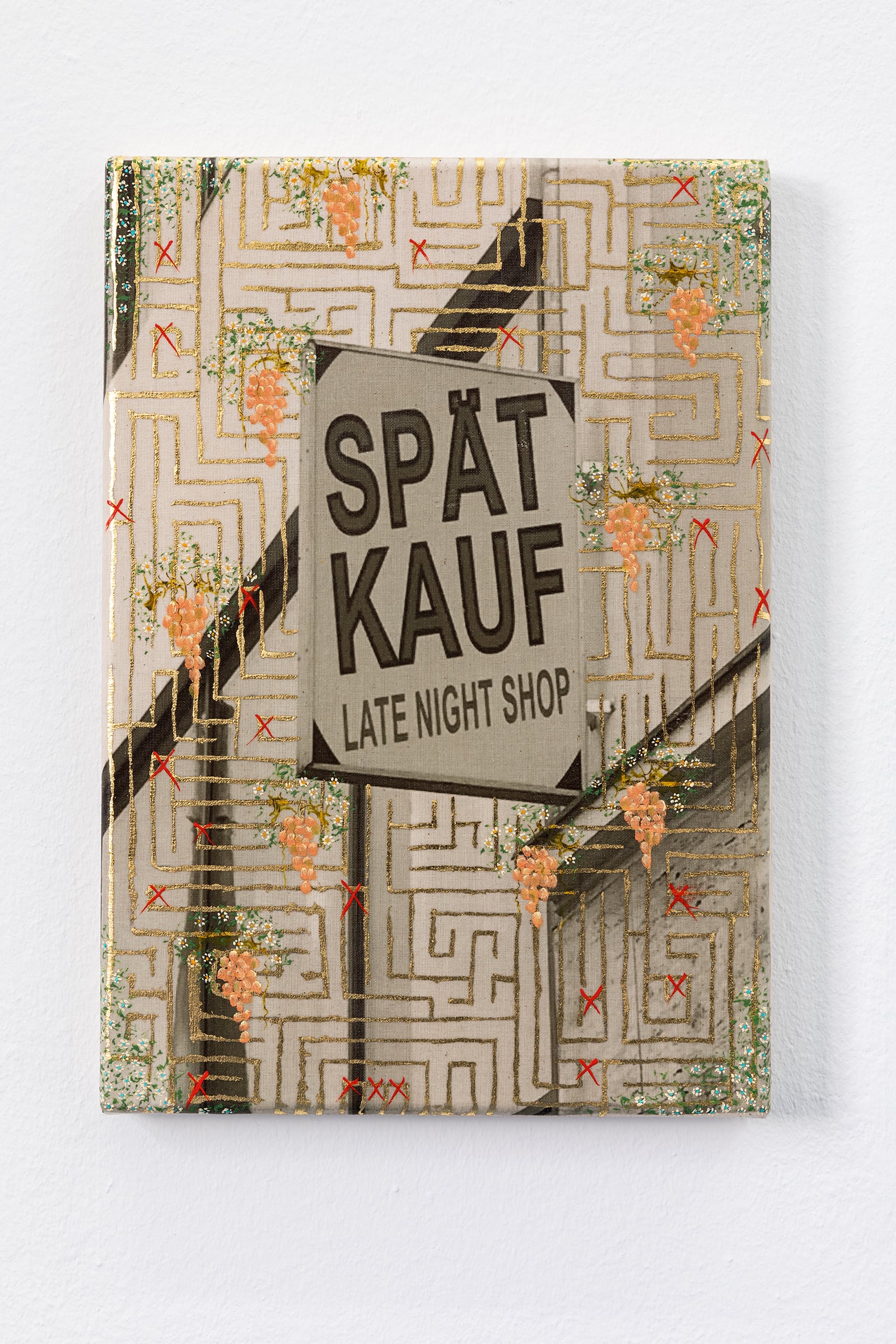 Elif Saydam, Zu spät III, 23 k gold, inkjet transfer and oil on canvas 30 x 21 cm, 2021
Elif Saydam, Zu spät III, 23 k gold, inkjet transfer and oil on canvas 30 x 21 cm, 2021
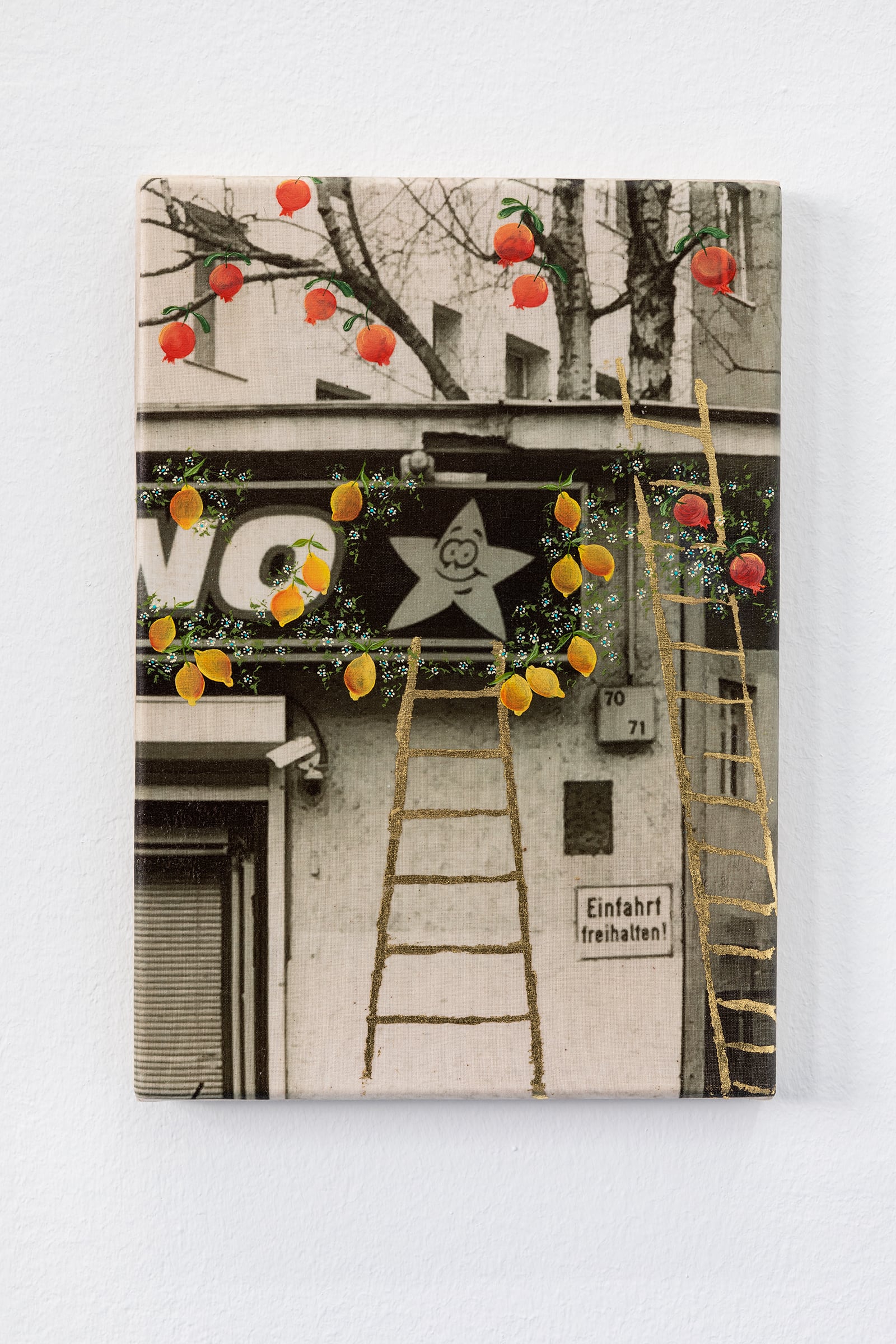 Elif Saydam, Mobility ;) , 23 k gold, inkjet transfer and oil on canvas 30 x 21 cm, 2021
Elif Saydam, Mobility ;) , 23 k gold, inkjet transfer and oil on canvas 30 x 21 cm, 2021
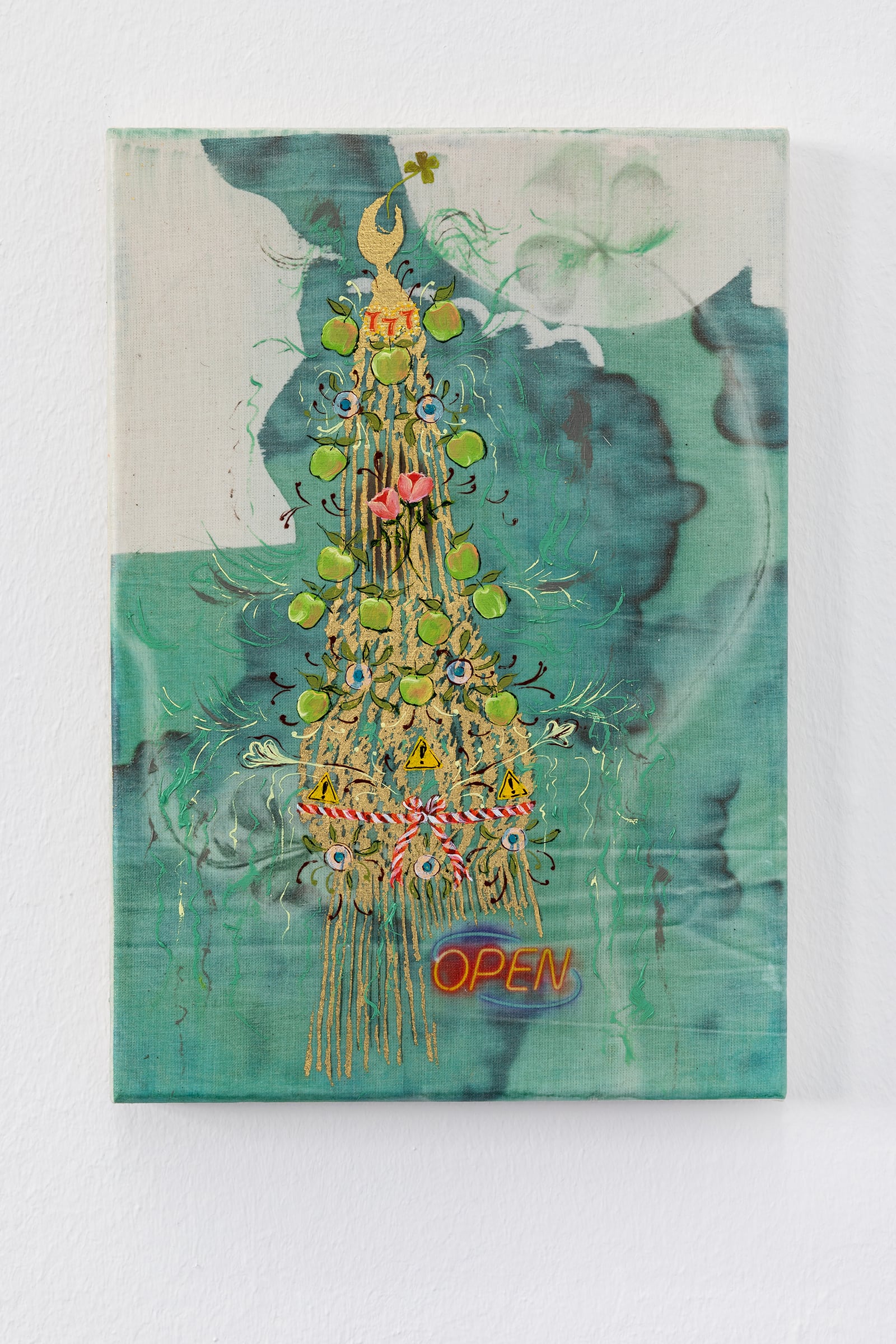 Elif Saydam, Free market, 23 k gold, inkjet transfer and oil on canvas 30 x 21 cm, 2020
Elif Saydam, Free market, 23 k gold, inkjet transfer and oil on canvas 30 x 21 cm, 2020
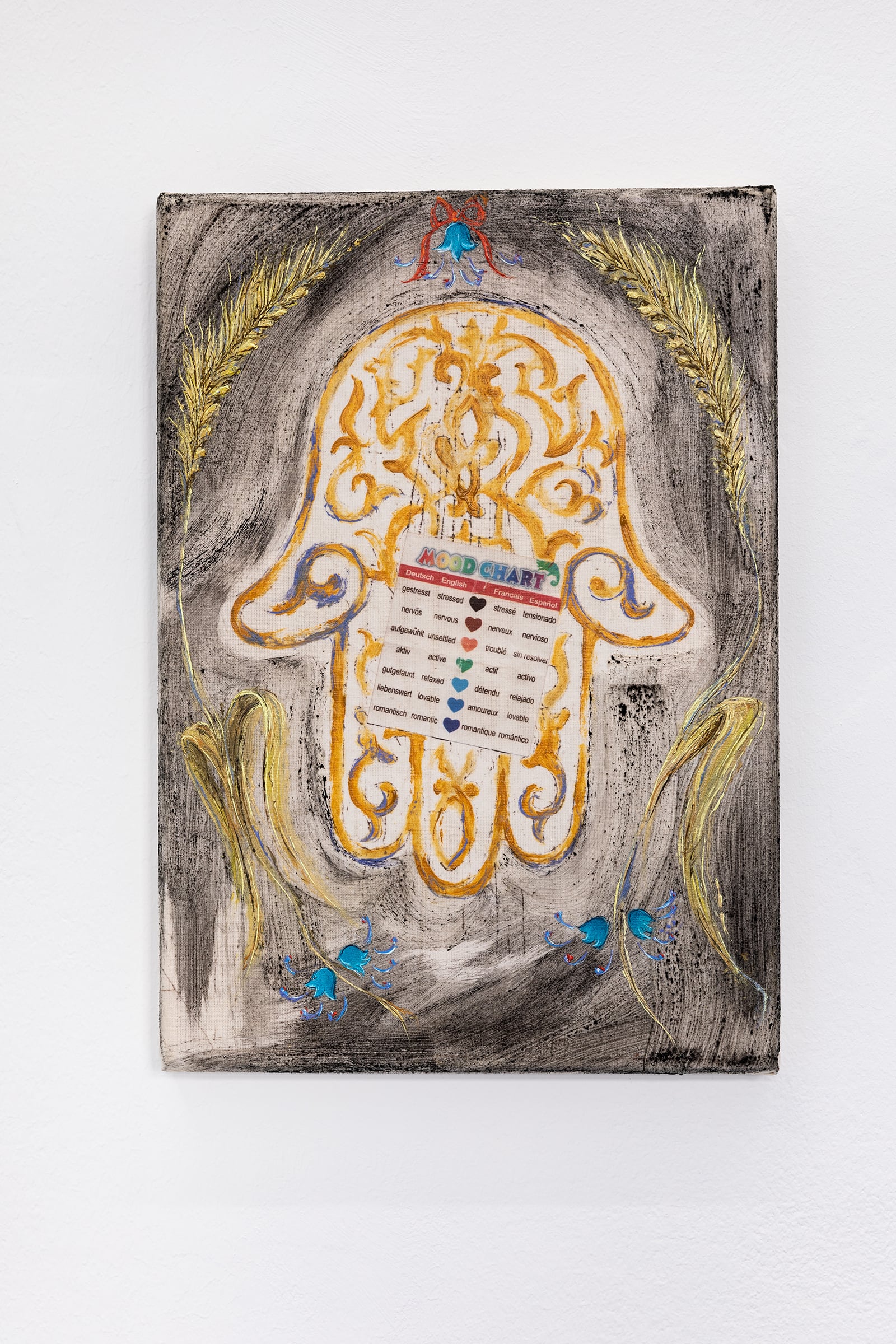 Elif Saydam, Fatima in the wheatfields, 23 k gold, inkjet transfer and oil on canvas 30 x 21 cm, 2020
Elif Saydam, Fatima in the wheatfields, 23 k gold, inkjet transfer and oil on canvas 30 x 21 cm, 2020
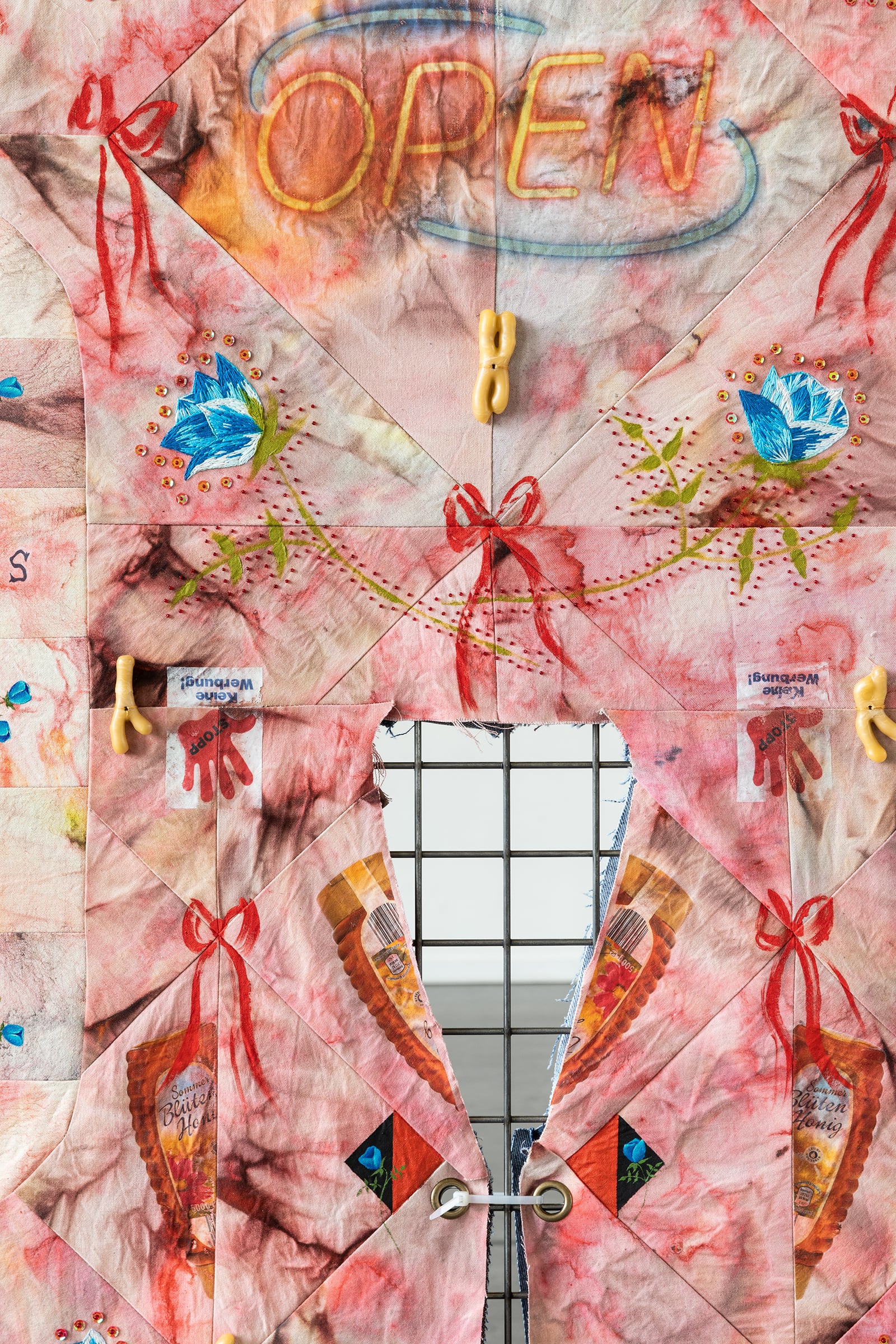 Elif Saydam, The Outlier I ,Beeswax, beads, sequins, embroidery, eyelets, inkjet transfers and oil on dyed canvas; steel frames 250 x 170 cm, 2021
Elif Saydam, The Outlier I ,Beeswax, beads, sequins, embroidery, eyelets, inkjet transfers and oil on dyed canvas; steel frames 250 x 170 cm, 2021
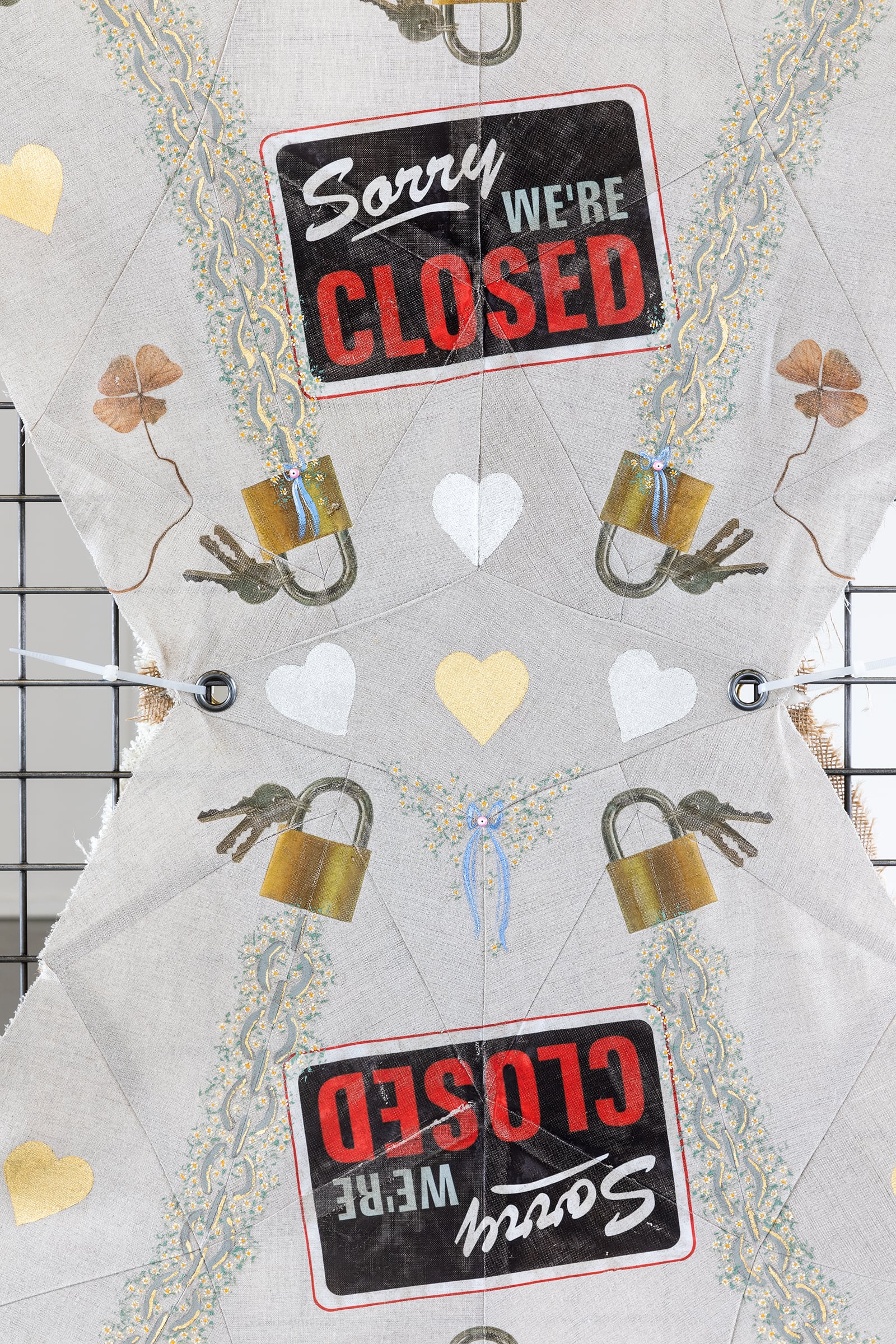 Elif Saydam, The Landlord II, Silk, beads, 23 k gold, 24 k gold, pure silver, eyelets, inkjet transfers and oil on linen; steel frames 250 x 170 cm, 2021
Elif Saydam, The Landlord II, Silk, beads, 23 k gold, 24 k gold, pure silver, eyelets, inkjet transfers and oil on linen; steel frames 250 x 170 cm, 2021
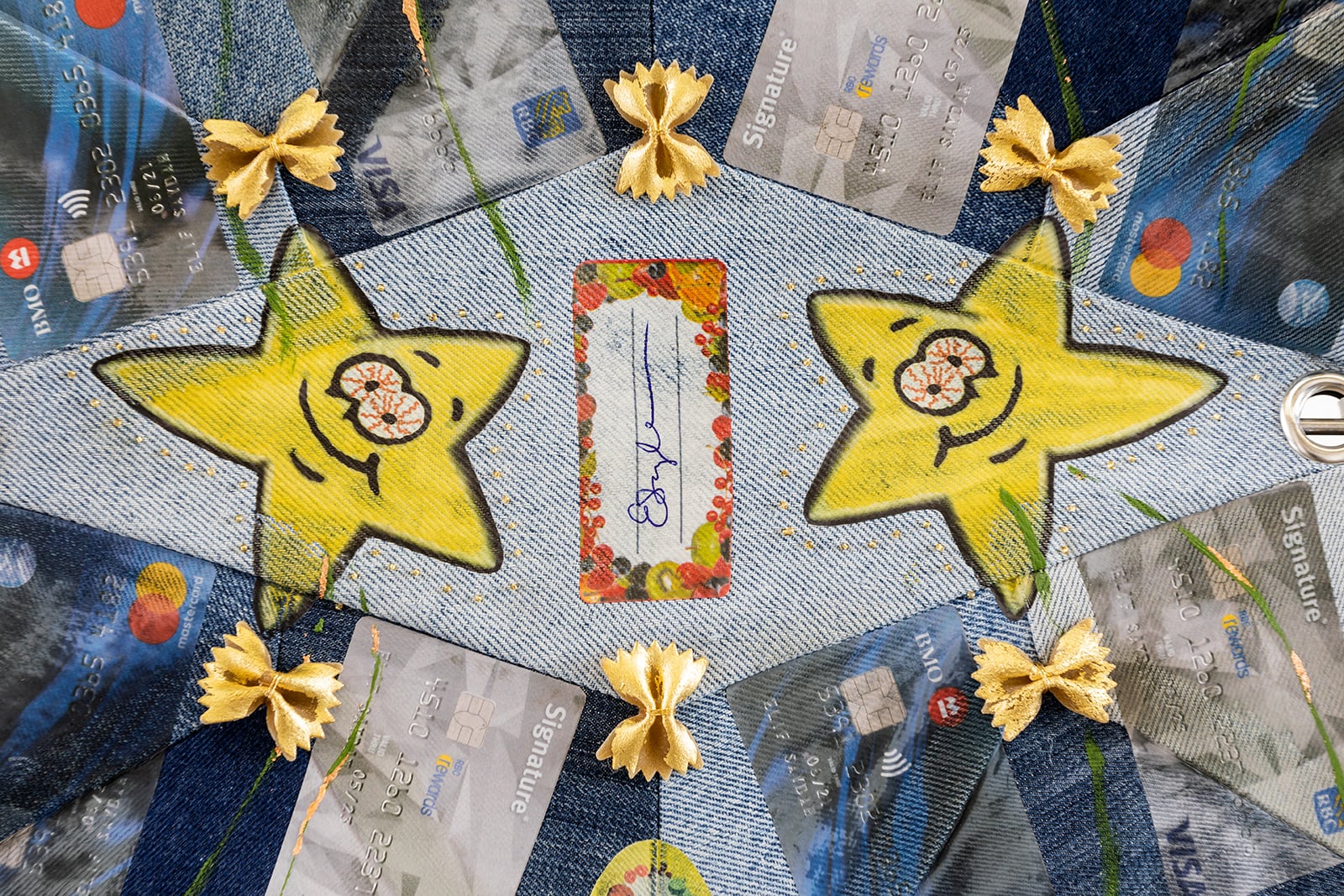 Elif Saydam, The Producer II, Farfalle pasta, 24 k gold, copper, orange slices, beads, sequins, embroidery, eyelets, inkjet transfers and oil on denim; steel frames 250 x 170 cm, 2021
Elif Saydam, The Producer II, Farfalle pasta, 24 k gold, copper, orange slices, beads, sequins, embroidery, eyelets, inkjet transfers and oil on denim; steel frames 250 x 170 cm, 2021
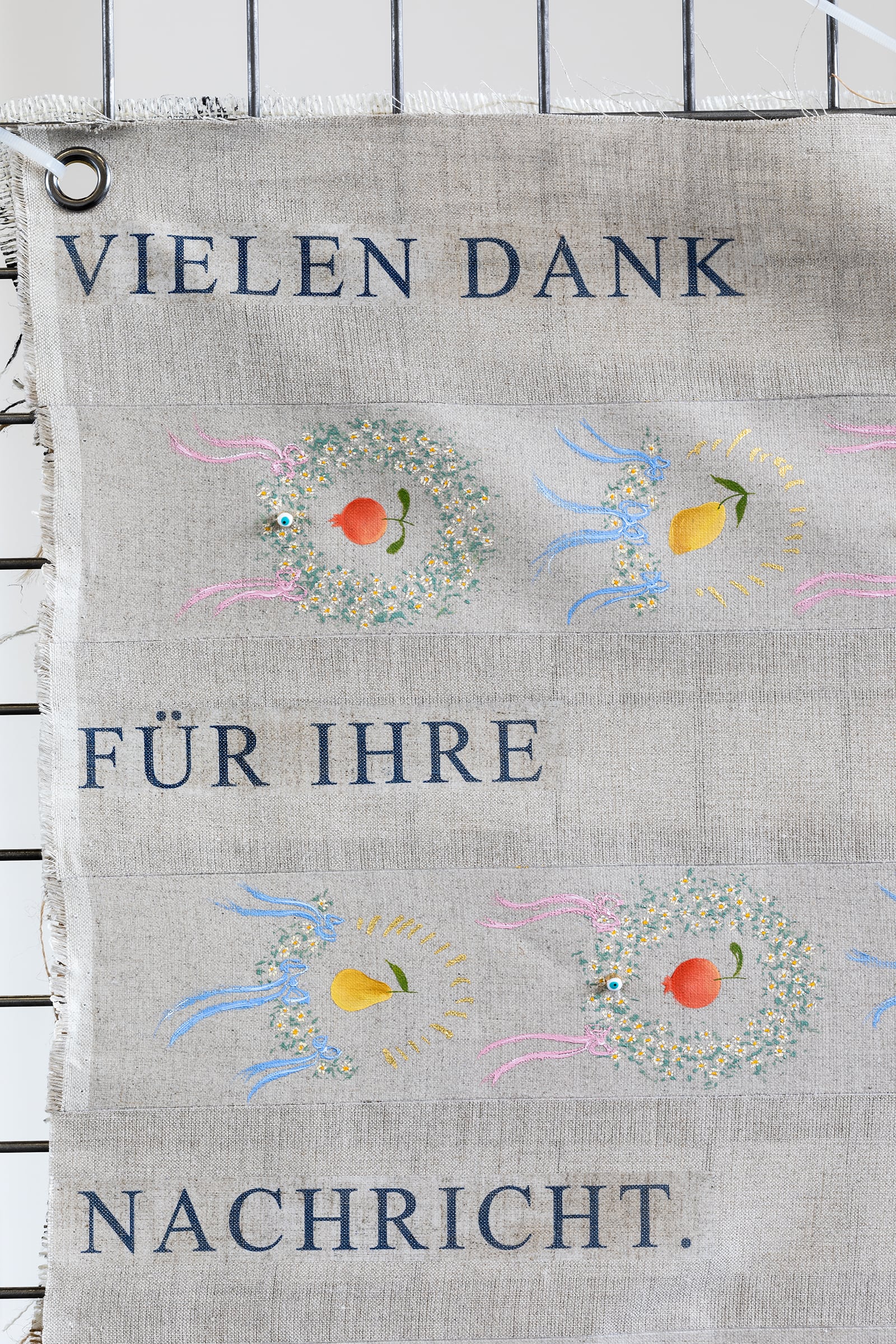 Elif Saydam, The Landlord I, Silk, beads, 23 k gold, 24 k gold, pure silver, eyelets, inkjet transfers and oil on linen; steel frames 250 x 170 cm, 2021
Elif Saydam, The Landlord I, Silk, beads, 23 k gold, 24 k gold, pure silver, eyelets, inkjet transfers and oil on linen; steel frames 250 x 170 cm, 2021
n their expanded painting practice, Elif Saydam (*1985, Calgary, Canada, lives in Berlin) addresses the relationship between social categories and the construction of taste. Drawing on decoration as well as the judgements and mechanisms they entail—both implicit and as exclusions—they raise questions around valued labor, identification impulses and social mobility. Saydam’s profound and humorous practice brings forth the connections between aesthetic and social ambivalences and their transgressive potential.
The history of the Kunstverein Harburger Bahnhof serves Saydam well: the former waiting room of 1st and 2nd class passengers of the Hamburg-Harburg train station had also been an intermittent gambling hall for a short time prior to becoming an art institution. Such conflicted histories and divisions are condensed in the back room, the so-called Blue Saloon, which had been reserved for nobility if not the emperor respectively, as the story is told. Here, Saydam converts the space into a chimeric hybrid through the intervention of a fluffy Spielhalle carpet, referencing the exclusivity of the room’s past and the original hand-painted motifs of the hall’s ceiling, but also the purgatory oen found near the one-armed bandits in the back of any old Kneipe. So much of living is about waiting; waiting to get rich quick, waiting for a train which may never come.
Do you know and remember the story of The Wizard of Oz? The fairy tale of four misfits searching for something they believe they lack? Oz himself is a pretender, tricking everyone with illusions that have nothing to do with the little man he turns out to be. It’s a children’s story—and an attempt at a moral fable. Everything turns out fine in the end, a fiction with a finite resolution. In reality, this search goes on forever and ever and ever, stretching to and beyond the limits, loaded with false promises lingering around continuously. How these promises feed into labor and consumption, how they relate to values, taste and class are instead the structural motor that keeps the system going, a perpetual motion machine. New labor forms and new consumers are generated constantly, but the roles that are to be fulfilled to reiterate the inherent logics are all set and manifest in architecture and symbols as well.
Saydam’s exhibition laments the highs and lows and in-betweens of social groupings and their aesthetic categorizations, transforming the Kunstverein’s main space into a scene of crucifixion for a royal suit of characters. Instead of religious idols, however, costumes embodying consumer role models are sewn, painted, adorned and flayed. In form, these reference Varvara Stepanova’s Constructivist workers clothing—prodezodezhda and sportodezhda—which were designed to outfit new ways of living in a post-revolutionary society. Within them the contradictions between desires and the perpetuation of performance, the tokens of what is needed to perform to succeed are literally being stretched out. It is indeed these promises for the good life—all geared towards ‘winning’—that constantly recur in Saydam’s works and the unsustainable exhaustion that comes along with it as well.
In their painterly interventions this ambivalence is played out in the juxtaposition of abstracted, cute-ified symbols and a more traditional use of imagery. Therein value is being questioned between trash and adornment. Imagine yourself in front of a fruit machine: How are grapes depicted and what do they represent? Imagine yourself in a royal palace, or the Sagrada Familia cathedral: What do grapes mean here? The treatment of symbols, objects etc., the labor and the material directed into them, is incorporated into the aesthetic perception. These affects tell something about how the world is constructed. And as it is heavily structured by ups and downs, the granting and depriving of accessibility and opportunities speak to this too. Saydam plays out these ambivalences for judgement of their works between front and back room, ceiling and floor.